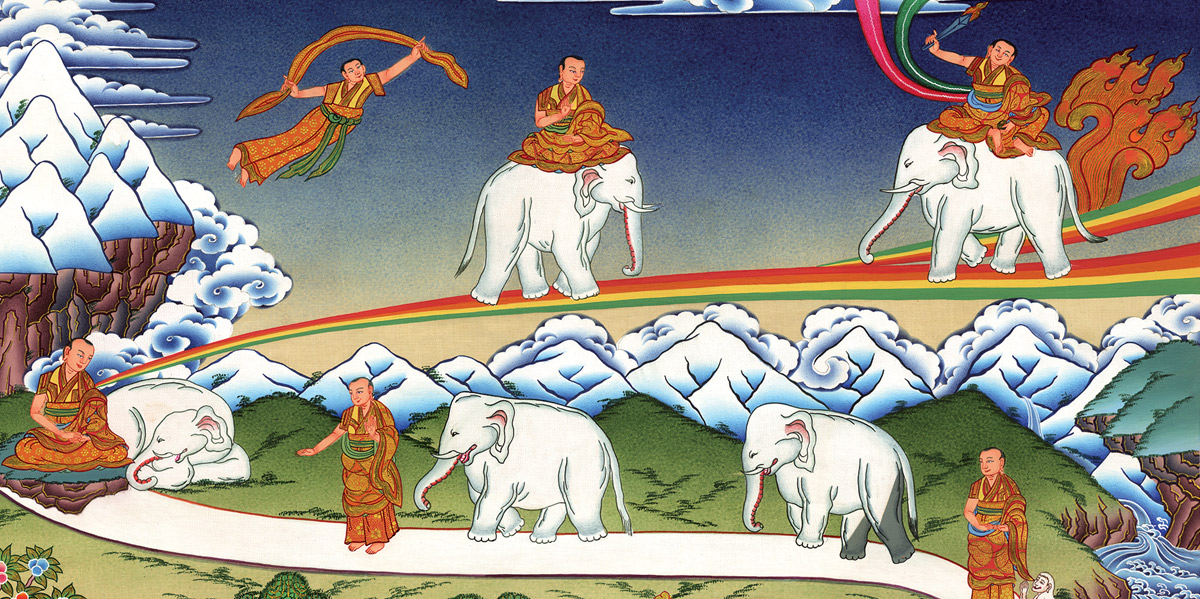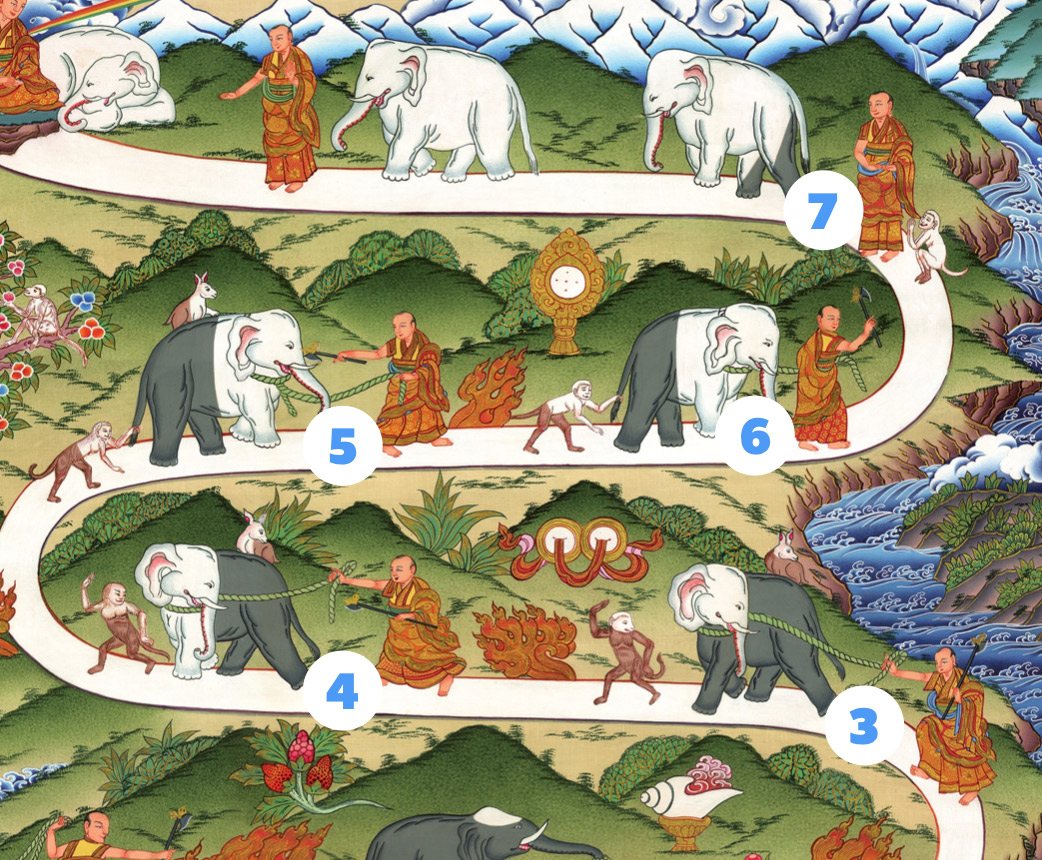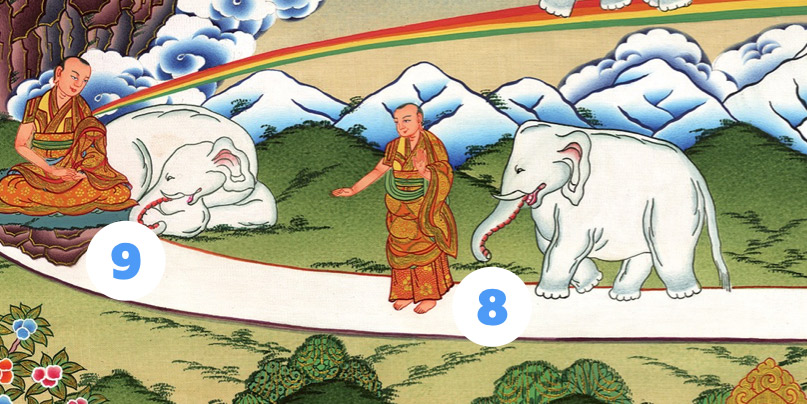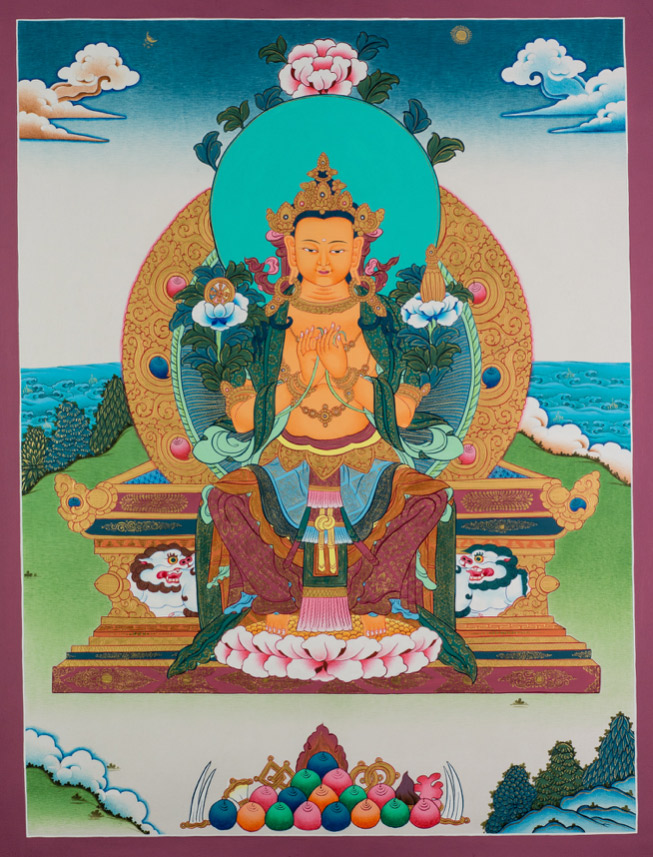
Shamatha (serenity, concentration) is Established
This is a transcription of an audio lecture that you can download for free:.
Most spiritual people drift from day to day in their efforts to be “spiritual,” and have no sense of where they are in their spiritual life, and worse, have no sense of where they are headed. Fortunately, in this era we have easy access to knowledge that tells us exactly where we are spiritually, and better, what we need to do to move to a higher way of being.
In terms of Meditation practice, real Meditation only becomes possible once we have established the prerequisites we have explained in this course. Today, we are going to examine the whole map of the stages of concentration so that we can easily recognize what stage we are experiencing and what we need to do to go further.
The teaching we are discussing is proven to be effective, and has been tested thoroughly by experienced meditators for at least 1,500 years. It works. It is not a gimmick. It is a science. Moreover, it is free. If you apply this teaching to your Meditation practice, it will dramatically change your experience of developing concentration. Moreover, you will be able to go beyond mere concentration. You will become capable of reaching the state of Meditation (Dhyana, Samadhi) and be able to gain insight into your problems and change them. That is the point.
Concentration / Serenity
The quality of Consciousness that we develop through these nine stages is very specific and exact. In Sanskrit is called Shamatha. In Tibetan, it is called shi-ne. Loosely, we translate this concept into English as “serenity, equanimity, concentration, equality.” Shamatha is not an intellectual concept or idea, or an attitude or belief. It is a state of perception.
These terms refer to a quality that is unwavering, steady, strong has a quality of brightness, and most of all, is cognizant, intelligent, aware. It does not arise by accident, chance, or as a boon from the gods. Instead, it is a quality of Consciousness that depends upon how we use our Consciousness.
Shamatha is a kind of serene concentration that perceives with equality or indifference: it sees without preference, judgment, predisposition, or desire. In other words, it is objective: it sees what is. That is what is necessary if we want to overcome suffering.
We already know that suffering exists because of causes. The Buddha Shakyamuni explained this very clearly in the Four Noble Truths:
- There is suffering
- Suffering exists because of desire
- There is a remedy for suffering
- The remedy is the eightfold path that liberates the Consciousness from desire
The eightfold path outlines how to establish shamatha and use it to liberate the Consciousness from desire.
Meditation has a purpose; it is to solve the problem of suffering. Firstly, we must solve our own problems, and stop our own suffering. To succeed in that we need a mind that is steady, serene, and capable of looking at the causes of suffering without being seduced, entranced, hypnotized. We need the ability to face our desires and see them for what they are: the causes of suffering. Shamatha, serenity, equanimity, concentration, provides that ability.
Throughout this course, we have been discussing this map that describes the stages of Shamatha or Shi-ne. There are nine fundamental, basic stages.

In order to understand these lectures, in order to understand these steps, we must be engaging in concentration practice daily. So a student who is following this series of lectures should now have been practicing daily two essential things:
Mindfulness
The first practice is to be conscious and aware in every moment, developing the power of mindfulness. That is the ability to be present in the moment and aware of what one is doing. This is absolutely essential to develop Meditation. If you do not develop mindfulness, you will never, ever meditate. Meditation is simply an extension of mindfulness.
Mindfulness must be engaged in a continual manner, all the time, without exception, without ever giving yourself a break. In the beginning, it requires enormous effort, an incredible amount of effort. It can feel exhausting, tiring, and even frustrating because we do not have the skill developed. We do not have the strength. We do not have the energy. It is hard. But that is how you begin learning to meditate. As with any new endeavor, one must be patient before skill begins to develop.
Daily Concentration Practice
The second practice one should be using daily is concentration. Every day, the student should dedicate a period of time to concentrate attention on one thing. Ideally, you do that by abandoning all the other senses, by disengaging from all other senses, not paying attention to the body, hearing, sight, smell, taste, or touch. 100% of attention must be on the object of attention. Everything else must be shut down. All attention should be on that one thing that you are observing.
In the beginning portion of the course we suggested practicing annapanna, observing the breath as the object of concentration. Breathing is a constant fact that is always there, and it can be observed without thought, analysis, speculation, etc. This is a valuable technique for preliminary practice. But, it has limits.
Then we recommended that the student go further: abandon observation of breath, and instead observe a recalled image. To do this, one must disengage from awareness of physicality, and pay attention only to the non-physical image. We suggested an image to recall.
In each stage, the student should sit in concentration practice for ten to twenty minutes a day, or even more when possible. The more effort one makes, the more results one will receive.
- For some weeks or months, observe the sensations of the breath in the nostrils. Once the mind is somewhat settled, move on to:
- Recall the image and observe it. Concentrate on the memory of the image.
All of that is absolutely necessary for you to understand what comes next. If you are not practicing those techniques daily, regularly, rigorously, intensely with a lot of devotion and dedication, the rest of this course will not help you. First, establish a consistent practice. Then, once you have experienced and recognized the first two or three stages of Shamatha, continue to study the rest of the course.
Distinguishing Features of Concentration
In the previous lecture we described how concentration, Shamatha, has several distinguishing features that are essential if we want to solve the problem of suffering.
1. Vivid intensity
The first one is a vivid intensity, an intense mental clarity. This means not only is the mind very still and stable, it also has the ability to perceive non-physical images clearly.
This is so important. Many of the modern so-called “Meditation schools” do not teach this. They avoid the power of the imagination. They set it aside as if it is something unnecessary, but they are mistaken. The power of the Consciousness is the power to perceive, not just physical imagery but also non-physical imagery.
If you do not have the power to observe the imagery that your mind is projecting all the time, then you can never solve your psychological problems. All of our suffering and our psychological problems are in these images that our mind is constantly projecting. If we avoid that, we shut that off and we refuse to see it, we are refusing to see the keys and clues that unveil why we suffer. This ability to have vivid intensity or intense mental clarity is essential. We develop that power through conscious visualization and conscious use of memory.
2. One-pointedness
The second feature is stability: one-pointedness. It is to have a psyche that is very stable, serene, and calm. This is the ability to pay attention to one thing without being distracted away from it.
These two essential characteristics are developed when we practice daily visualization: concentration on an image that we imagine. For most of us, that is difficult, which reveals that we do not have sufficient concentration. As we practice, that skill is naturally developed.
When we were children, we could imagine very easily. We could remain very concentrated on our imagination very easily. However, when we became teenagers, we began to misuse all the energy in our body, heart, and mind. We squandered that power. We lost it. As we became adults, we squandered it even more. We became so focused on physicality, material things, that we neglected the nonphysical aspect of life. When we become spiritual, we want to reconnect with non-physicality. Developing the power of imagination / visualization again, restoring it, is precisely how we reconnect.
That development passes through nine very scientific and very precise stages. Again, they are not vague, they are not open for interpretation. They describe very precise qualities of concentration.
Stages of Tight Focus (1-2)
The essential basic practices are constant mindfulness and a daily period of time dedicated to concentrating attention. In other words, we need to work on focusing attention on one thing and being aware of doing it. We should be doing that twenty four hours a day. Someone who is serious about doing that immeditately begins to recognize that the mind is out of control. The psyche is a chaos. Thoughts just keep happening. Not only that but most of the thoughts are completely useless, totally repetitive, and most of the time completely negative, even harmful and dangerous.
Seeing the wildness of the mind can be a very uncomfortable realization. That discomfort demonstrates the need to change. With courage and with effort, you can change. If you avoid these facts, you will only prolong and deepen your problems.
If you practice constant mindfulness and the daily effort to direct attention, gradually the mind begins to settle. That is what the first two stages are about, which we discussed in the previous lecture. By having focus, we begin to change that scattered nature of attention and focus it.
When we lack shamatha (serenity), our attention is very scattered, constantly scurrying around like the monkey that we see in the painting. Because of that scattered, wild condition, our concentration is very shallow; it only sees the surface of things. It thinks it is very smart, and can see everything, but if you are really honest with yourself, you will notice that this tendency of your mind to wander around, to jump around and be very distracted, is extremely superficial. It absolutely cannot penetrate into the depth of anything. If you want to prove it to yourself, try to read a book. Notice how far along you get before your eyes are still moving along the page but your mind has drifted away to other things. Then you have to back up and find where you have lost the thread of what you are studying. The same happens when we watch a television show, and the same happens when we listen to lectures like this one. How many times has your mind wandered away from what you are supposedly concentrating on?
The facts of that behavior demonstrate that we are unable to penetrate into the depth of anything. Since we cannot hold attention at will for any length of time, we have a very superficial and shallow degree of concentration. That state of concentration corresponds to the lowest stages of this graphic of Shamatha. It is very scattered and very shallow. We cannot concentrate, we cannot focus, we cannot direct it, and we cannot penetrate into anything.
Little by little, with the practice of mindfulness and directed attention (concentration), we start to gather together that power. It starts to focus. It becomes more and more penetrating, more and more able to stay on task. Because of that, we will be able to penetrate into the meaning of things, to see through the surface level, to see deeper. This includes anything that it observes, not just physical things, but psychological and spiritual things.
Consciousness is energy. It produces consequences according to how we use it. If we are smart and we learn to use it well, it can produce comprehension, understanding, insight, and wisdom. That is really what we want. That is Prajna.
Stages one and two of shamatha are called the “stages of tight focus,” which means that we have to have a constant effort to tightly redirect attention to the object. It is a battle because that monkey is constantly distracted.
We call it “tight focus” because it is somewhat like gripping on to something when you are in a storm. The power of the storm threatens to sweep you away, so you have to hold very tightly onto an anchor, otherwise you will be washed away by the chaos. This is exactly what you face when you begin the practice of concentration, when you have no training yet. The state of the mind is that storm. It is caused by that monkey that is always hopping about. So holding your attention onto that object is like holding onto an anchor in the midst of a hurricane. Little by little, the more effort you make, the more you apply yourself, the more you learn how to hold attention. Eventually, it becomes effortless.
Stages of Intermittent Focus (3-7)
The next broad phase of concentration practice is called “stages of intermittent focus.” These are illustrated as stages three to seven. During this phase of practice we move from an unsettled, chaotic mind to one that is becoming more settled, thus we are more focused.

Stages three to seven are marked by an increase in the length of time we are concentrated, and a decrease in the time we are distracted.
In stage number three, we are more distracted than we are concentrated. For example, if we practice concentration for twenty minutes, of that maybe fifteen, sixteen or seventeen minutes we were distracted. Throughout those twenty minutes, we were concentrated for perhaps three or four minutes — the exact time does not matter, we are comparing the proportions of time: most of the time we are distracted, and some small part we are concentrated and aware of what we are doing. It may not sound like much to be concentrated for only three or four minutes out of twenty, but that is an accomplishment, and a definite improvement over being distracted for twenty minutes straight.
Little by little, as we advance in our practice by making effort, that ratio begins to change. The time that we are aware of what we are doing — we are mindful and concentrated — becomes longer. The period of distraction becomes shorter. That is why these are called stages of intermittent focus.
3. Patched Placement and 4. Close Placement
Stage three is called patched placement. Stage four is called close placement.
These terms “patched” and “close” simply indicate the changing ratio between being concentrated and being distracted. “Close placement” means that the times of distraction are decreasing, while the times of being aware and concentrated are increasing. What marks them as stages three and four is that the time of distraction is longer than the time of being concentrated and mindful of what one is doing.
We advance from stage three to four and onward by developing the power of mindfulness, by constantly being aware of yourself and what you are doing. For this to happen, mindfulness is not only something you develop in concentration practice, but instead must be strengthened and expanded in everything we do, all day long.
If in your spiritual practice, in your daily effort to concentrate, you are finding that the period of time that you are distracted is longer than the period of time that you are attentive, it is because your mindfulness is not strong enough. That means you need to focus your effort on developing mindfulness throughout the day, in your daily activities, at work, at home, and in everything that you do. Become more mindful of what you are doing. That effort to be present here and now will then change your concentration practice, because you will naturally also be present at that time. If you do not develop mindfulness during all of your daily activities and you just keep concentrating or observing your breath for a few minutes every day, your experience will not change. Eventually you will give up on Meditation; you will quit. This is what happens to a lot of people. They may sit and try to meditate for an hour or two but the whole day they are distracted. They do not pay attention to themselves during the day. That is why their Meditation practice fails.
To move through stages three and four is achieved by developing mindfulness.
5. Taming and 6. Pacification
The person who is developing mindfulness from moment to moment and daily concentration practice will easily reach stages five and six of establishing concentration, which are called taming and pacification. Simply stated, in these stages you generally do not forget yourself, and your attention does not stray easily.
So, at these stages, mindfulness is not so much the problem anymore: you have established some degree of mindfulness of what you are doing, meaning that you generally do not forget that you are meditating, or performing whatever activity you are performing. This is good, yet it is also a moment when you can fail.
It is easy to become lazy at this stage, and feel as though you have reached concentration or Meditation. That is why in the painting there is a rabbit on the back of the elephant. That rabbit represents laziness that wants to stop making effort and enjoy the experience. This is a dangerous stage because it is easy to stop there and think, “Now that I have reached this degree of concentration, I know how to meditate.” But, that is not true. These are just preliminary stages developed with preliminary techniques. This is not Meditation yet.
To advance through stages five and six, we need to increase the power of vigilance, which is that part of our attention that watches for the obstacles we described previously. Specifically, we need to look for agitation and dullness. We described those in the previous lectures.
7. Complete Pacification
By having that little bit of attention or vigilance watching for the obstacles and then applying the antidotes when necessary, one can advance past five and six and reach stage seven. Stage seven is called “complete pacification.”
In this stage, you are able to remain attentive in your practice, and while maintaining concentration on your object, you are also able to be vigilant about the presence of subtle thoughts, emotions, and other elements, and through recognition of them “pacify them,” meaning they have no power to distract you.
That is why here we see that the elephant is no longer being led by the monk. The monkey has become passive. That is why it is called “complete pacification.”
This is still a stage of intermittent focus. There is still that portion of practice where distraction occurs and we forget what we are doing. We become distracted.
To successfully move past stage seven we simply need enthusiasm, the effort to continue practicing. We already have mindfulness for most of the time, and we already have vigilance to recognize obstacles. So, from stage seven we simply have to keep practicing.

8. Stage of Uninterrupted Focus
In stage eight we see the elephant following the monk, but no monkey; the monkey is gone. This means that that distracted aspect of the psyche has been pacified. The psyche has become tamed. Thus, this stage of practice is called “one–pointed placement.”
It is called uninterrupted focus because when you sit to do your concentration practice, you never forget what you are doing and you never become distracted, no matter how long you practice, even for hours. This is a beautiful experience. However, it is still not Meditation. This is just a stage of concentration.
This stage requires only a slight effort to maintain concentration and mindfulness. It is a slight effort, not nearly as intense as it was in the beginning.
9. Stage of Spontaneous Focus
At stage nine, the ability to have uninterrupted focus, to have the mind placed perfectly on its object, then becomes completely effortless. The previous stage (eight) still requires slight effort to maintain concentration. However, in stage nine, there is no effort. Stage nine is where you experience actual Shamatha, Shi-ne, or calm abiding. This is a wonderful accomplishment.
To firmly establish the ninth stage, to get from the eighth to the ninth, you need only to develop familiarity with it.
Little by little your concentration training becomes so complete that it no longer requires effort for the psyche to be in that stable and calm focused state. This is what we call one-pointedness.
In Zen or Chan or other traditions, they talk about having one pointed concentration. This is what in Patanjali’s Yoga Sutras is called Dharana. If you have studied Patanjali’s Yoga Sutras, you know that Dharana is not the end of Raja Yoga (Ashtanga): after that come Dhyana and Samadhi. It is the same here. Stage nine is not the end of Meditation practice. There are other stages beyond stage nine. Shamatha, one-pointedness, is where real Meditation can begin.
Who Can Accomplish Shamatha and What it Means
Anyone can experience these stages of concentration; there is nothing supernatural about them, or mystical, nor does one have to be specially blessed or empowered. Developing shamatha is not difficult. It just requires a bit of knowledge and a bit of practice.
Nevertheless, even if you reach the ninth stage and have developed shamatha, you are still only a beginner. Stage nine means only that you can place attention without being distracted. It does not mean that you have understood anything at all about karma, suffering, your psyche or about reality. It just means that you now have the type of mind that is ready to be trained to meditate, and be effective at it. That is why it is a prerequisite. Shamatha is not Meditation itself. It is a prerequisite for Meditation.
Stages of Effort
We just outlined four essential stages of directed attention or focus. It is important to understand them in our practical experience. We need to observe ourselves — the facts of our spiritual life — and compare those facts with these four stages.
Most of the people who hear about Meditation and even try to practice never move past stage one. Those who do establish some daily effort may experience the second or third stages, while a few of them who practice seriously may drift among the middle levels. But in general, most meditators — especially in the Western countries — practice without any sense of where they are in their practice, because they do not know the stages of concentration. You have now heard of them. The next step is to recognize them in your own experience. Then, learn to work with them and go beyond them.
If you learn this science and become able to recognize the obstacles and maintain your practice, you can move through all these stages of focus until you develop the ability to maintain a spontaneous focus, directed attention that is effortless. In the beginning it takes a lot of effort. But as you become accustomed to the training, eventually you reach a stage where it is effortless. Doesn’t that sound wonderful?
Observe yourself: do you feel that Meditation is very hard? From that observation, you can immediately recognize that you are in the beginning stages of developing concentration. That means that you do not know how to meditate yet, and you also do not know how to concentrate yet. I am not trying to be cruel, it is a fact proven by this science.
Consider stage eight, uninterrupted focus; at that stage you have no interference from agitation or dullness. You are able to maintain long concentration sessions without any real effort. Practicing at this stage is not hard or difficult. It is easy. That means someone who is accessing that stage does not suffer while meditating. It is not hard.
With familiarity, they reach stage nine, which means there is no interference at all from the body or the mind. There is no exertion to meditate. They simply sit. Moreover, directing attention is absolutely effortless. They do not struggle. They are not fighting the body or the mind. They just sit. The mind is calm, the attention is focused. It is easy and simple.
- 1-2. Tight Focus. Requires strenuous effort.
- 3-7. Intermittent Focus. Interference of agitation and dullness. Unable to maintain long sessions.
- 8. Uninterrupted Focus. No interference by agitation or dullness. Able to maintain long sessions.
- 9. Spontaneous Focus. No interference, no exertion. Effortless focus.
When you observe your mind saying: “Meditation is too hard. I cannot concentrate. It is too difficult. I can’t do it. I don’t understand. I am not capable. I have bad circumstances. My life does not allow it.” When you observe your mind saying all this kind of nonsense, you immediately know where you are in the stages of concentration. You are not practicing in the higher levels. You are in these lower levels. So now you know where you are. Now you know what you can do to change it. You will have to work hard, but consider the benefits you will receive. The work is worthwhile.
If you are serious about developing mindfulness and concentration, you will very quickly experience these upper levels. It is not that difficult. It can be done by anyone who makes effort. Even if you are paraplegic and you have all kinds of diseases, you can still do this. Really, especially in the West, no one has any excuses. If you are living in a war zone, then I can understand why it would be difficult to accomplish this. If there are bombs dropping on your neighborhood then yes, it would be very hard. But for everyone else, no. There is no excuse. If you are not doing it, it is because of laziness, defeatism, shame, too much lust, too much envy…
Furthermore, you will advance through them even faster if you are serious about conserving and transforming your sexual energy. Truthfully, if you are wasting your sexual energy through the orgasm, then none of this information will help you at all. The steadiness of the Consciousness is impossible if we are still handling our sexual energy like an animal. Nevertheless, for those who harness that energy and steady it, the mind will steady very rapidly at the same time.
Notice that the effort to develop concentration is exactly the same as the effort to steady the sexual energy. In the beginning, it seems impossible. But with willpower and consistent practice, both eventually become effortless. This is because both the steadiness of the mind and the steadiness of the sexual energy are the natural, normal condition we once had, but lost, because of desire.
That is why we need to understand that the higher stages of developing meditative serenity are effortless. Real concentration, real serenity, is effortless. From that effortless observation, the state of Meditation can be found.
Pliancy
There is a quality that definitively marks the establishment of concentration. It is called pliancy (Sanskrit prasrabdhi प्रश्रब्धि; Tibetan Shin-sbyangs ཤིན་ཏུ་སྦྱང་བ་).
Pliancy means “serviceability of body and mind.”
When you have pliancy fully established, the body and mind obey without hesitation.
What does that mean?
Observe your resistance towards Meditation. You may tell yourself: “I am going to develop a serious Meditation practice. This week I’m going to meditate every day for half an hour.” That sounds completely reasonable. But then when the time approaches when you actually need to meditate, your mind and body will not accept it. You may be interested in Meditation, yet when it comes to actual practice, your body and mind fight very hard against it.
What happens when it is time to practice concentration? Our body complains constantly. It feels discomfort, itchiness, pain here and there. It is distracted by sounds, temperature, the chair, the cushion. It is hungry, thirsty, tired, agitated. In other words, it has a huge range of tools it uses to fight against your will.
The mind does that, too. It comes up with a million reasons why you should not practice. Your mind seeks any kind of evasion to prevent you from practicing.
Of course, this applies to every part of spiritual practice. What about Chastity? The mind has lots of excuses for why you cannot be chaste. What about studying scripture? The mind has lots of excuses for avoiding study. It will not do it.
The body and mind fight because right now they are in control of each of us. The animal mind, the animal body, control the Consciousness. Liberation is about becoming free of the animal. You cannot become human while you are trapped in animal behavior.
Do you see in the painting at the very top that the meditator is served by the elephant? Here, the Consciousness, the soul, is in control of the animal. The animal serves the Consciousness. That only is reached through Meditation training. There is no other way to reach it. It is through this science.
If you make effort every day to develop mindfulness and concentration practice, you immediately begin developing pliancy, because you are training your body and mind to obey you, the soul, the Consciousness.
Your body is not who you are. Your mind is not who you are. You are the soul, the Consciousness, what is called Tathagatagarba, Buddhadhātu. These are all terms that describe our essential nature. That is not the mind. That is not the body. Mind and body are afflicted with dysfunction, which is why we suffer. We suffer because we allow the animal mind and animal body to control of us.
Instead, we need to control them. The soul, the Consciousness, needs to be in charge of our psychological house. When you start the practice of developing mindfulness daily and developing concentration daily, you start telling the mind and body: “You! Sit down and shut up!” They fight, but they really have no choice. The soul is willpower (Tiphereth).
Let us observe this on the Tree of Life.
The physical body is represented by the sephirah Malkuth.
The energy that activates this body is represented by Yesod.
The emotions that we feel are represented by Hod.
Thoughts are represented by Netzach.
Those sephiroth constitute the body and mind.

The sephirah Tiphereth is willpower. It is the human soul. That is who we are as a soul, as Consciousness.
Right now, the Consciousness / soul is trapped in desire for sensations, trapped in lust, anger, pride, shame, greed, gluttony, fear, anxiety, etc. We need to liberate that willpower from desire. We do that by strengthening willpower. Will-soul needs to be in control of body and mind, otherwise liberation is impossible.
The moment we begin making effort to develop mindfulness and concentration practice, we are using willpower to take charge of body and mind. That means in that very moment we are also starting to develop pliancy (serviceability of body and mind) — if we actually do use willpower, and practice.
In the beginning, practice is difficult. It is a fight of will versus body and mind. We place the body in a posture. We tell the mind: “you be quiet, I am paying attention to my object.” The mind is going to fight. It is going to bring every distraction it can to try to regain control.
Through all the beginning stages, we are fighting and fighting to establish concentration. Really what we are fighting for is control over our life, over our future. If we let the animal body and the animal mind control us, we will live the life of an animal and die as an animal. If we want to be a human being, that animal must serve the human being, not the other way round. This animal must be tamed. So though daily effort, everyday without any exception, we train. Not with violence and cruelty against the body and mind but with the rope and hook: vigilance and mindfulness.
Gradually, little by little as we practice every day, we train the mind and body to obey our will. Throughout that process, we are increasing pliancy. It is fully established when we reach stages eight and nine, Shamatha.
Pliancy is something that we experience. It is a definite, definitive, absolutely real experience. Pliancy is not a vague term or open to interpretation. This is something that can be unquestionably identified by the one who experiences it. There is no doubt about it when you have pliancy. Pliancy means that the body and mind happily comply without any resistance. They are happy to serve you, the Consciousness (Tiphereth), and are joyful about it. So when we want to meditate, there is no effort. There is no fight. There is no struggle. It is effortless. Remember stages eight and nine that we have just described. It is effortless Meditation. There is no struggling and no fight. Body and mind are ready. They are trained, serviceable, calm, relaxed and serene. Joyful! What a wonderful experience that is. We all want that and can have that.
On the painting, pliancy is represented by two images, the flying monk (a) and the monk riding on the elephant on the rainbow (b).

The flying monk represents pliancy of the body. This is actually physically experienced (not that you are going to literally fly). You can sense and feel pliancy physically in the body. It is where the body — according to our degree of development — has a great deal of relaxation. It is completely ready to meditate and gives no problems for the entire duration of Meditation. Swami Sivananda said that someone who has truly developed their Meditation practice can sit perfectly still for three hours or have no pain, no discomfort, no urgency to get up and do anything else but to just sit in such contentment and happiness. That is pliancy of the body.
Beginner meditators who observe the advanced ones wonder, “Wow, how do those guys sit in Meditation for eight or ten hours every day, in a cave or little box? It looks so uncomfortable.” We cannot imagine; to us, it sounds like torture. We try to sit that way for ten minutes and we are in so much pain. Meditators who have concentration, shamatha, have pliancy. The body does not complain at all. The body is happy to do it because it is trained. The body has been trained by the Consciousness. It is a willing servant. It is the same with the pliancy of the mind, which is what the elephant represents. It is happy to perform that task. It is the task that it is given to us. It is why we have a mind. The mind exists to accomplish that task.
Pliancy is an absolutely definitive sign for someone who has achieved Shamatha. Why is this important? There are many people who study Meditation, who really enjoy the subject matter, who are quite well educated in the terminology, who may be able to appear to sit well. They even convince themselves that they have achieved a degree of concentration and can access stages of Dhyana or Jhana or the various types of formless or form-realm concentration states, but they do not have pliancy. They struggle to reach those states. They struggle with the body. They struggle with the mind. What that struggle reveals is they do not have Shamatha. They may have some ability to concentrate. They may have some ability to control the mind and body to a degree. But they do not have pliancy, which is that spontaneous serviceability of mind and body.
We point this out because it is easy to deceive ourselves in this type of work. Pride is always ready to leap in and say: “I’ve done it. I have accomplished something. Now I am an accomplished meditator.” What a lie that is. So many people fall into this trap. That is why we always watch for these scientific signs. We have take the I out of it. None of these stages has anything to do with the ego or the I.
The bottom line is these nine stages are quite simple. When you study them and you get familiar with how they work, they are not complicated. These are the ABCs of concentration. But these ABCs, these basic steps, are only a preliminary stage of Meditation practice. They only take us to the point where we can sit in peace and be concentrated. It is from there then we can then apply new skills to acquire comprehension. Concentration by itself does not lead to liberation. It cannot. Concentration is simply the ability to focus attention on one thing and hold it there. That is all it is. By itself, it does not liberate.
For liberation we need something much more powerful than mere concentration.
Observe on the Tree of Life:
- the sephirah Malkuth the physical body
- Yesod, energy in the body
- Hod, emotion
- Netzach, thoughts
- Tiphereth, willpower and Consciousness
If we are sitting to meditate or concentrate and we do indeed have pliancy, then the body, energy, emotion, thoughts are all perfectly relaxed, perfectly under control with pliancy. They serve the will of the soul. That means that all these lower sephiroth are not obstacles to the Consciousness. They are serving the Consciousness. They are that elephant in the painting that the Consciousness is using to walk along the rainbow. It is in that state, only in that state, that the Consciousness can then be liberated, even for an instant, to experience its true nature and subsequently comprehend reality.
Exercises
Develop your mindfulness during the day. This effort is the very foundation of everything you ever accomplish spiritually. If you do not know how to observe yourself, to be mindful all the time in everything you do, you will always be in the state of ignorance. To advance your spiritual life, you need to know yourself, not as you think you are but as you actually are. That is developed and acquired through self-observation. You can see through constant mindfulness of what you are doing, you start to acquire information about your suffering, your actions and your behaviors. Without that information, you can never solve the puzzle of your life. This is so essential.
The second exercise is to develop meditative concentration. At this stage of the course, we need to be working with visualization. So we provide this image of a seated Buddha.

All you need to do is observe that image for a moment, then close your eyes and visualize it. That is all. It is not hard. Do not struggle. Do not fight with that visualization. Let it happen by itself. Just the same way you can recall any other memory, just remember the picture. Don’t strain your eyeballs. Don’t twist your body in contortions and become tense making great effort to force the image. That is contradictory to what we are trying to achieve. Simply relax, close your eyes, and you will remember. If it is not stable or clear, it is because your concentration is not strong yet. You just keep trying. If you are distracted, just start again. Keep trying. Little by little you will accomplish it.
The third exercise is to continue with your spiritual diary (Practical Spirituality 02 Spiritual Diary PDF). Continue using that as a tool to acquire insight into your behaviors.
This information was originally published on gnosticteachings.org. You can find more lecture transcripts by visiting them online.






















Sorry, the comment form is closed at this time.